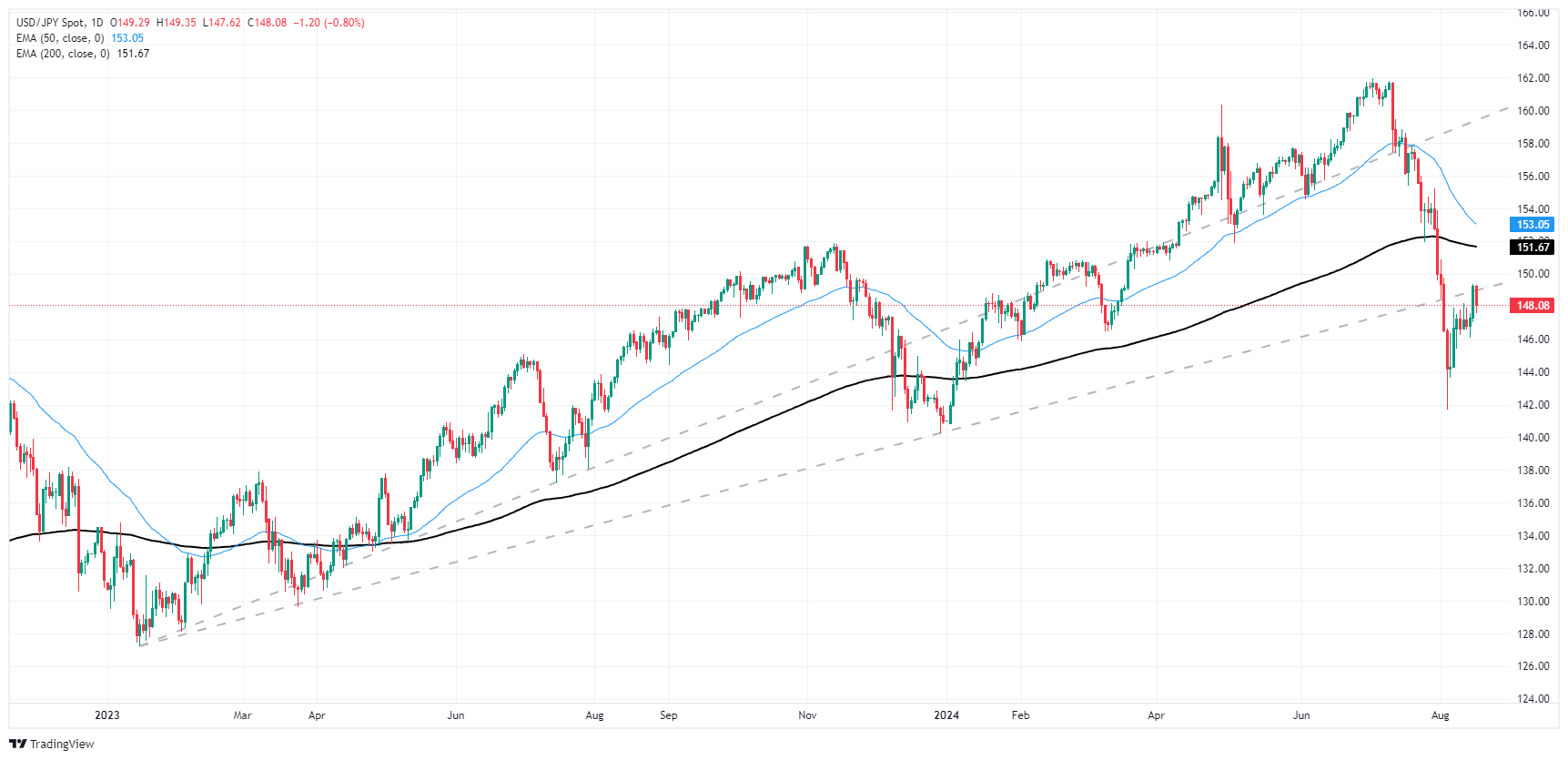- USD/JPY waffled back below 149.00 on Friday as risk appetite recovers balance.
- The US Dollar sees selling pressure across the board to wrap up the trading week.
- Coming up next week: Japanese national inflation data and the start of Jackson Hole.
USD/JPY eased lower on Friday, slipping below 149.00 early in the day and testing near the 148.00 handle. The US Dollar is getting sold off across the board as broad-market sentiment recovers on the back of an upturn in US consumer sentiment figures.
The University of Michigan’s Consumer Sentiment Index showed a firmer-than-expected recovery in surveyed consumers’ outlook in August, rising to 67.8 from the previous 66.4, handily beating the forecast 66.9. Investors grabbed ahold of the headline print and piled back into riskier assets while selling the Greenback, despite the UoM 5-year Consumer Inflation Expectations in August holding steady at 3%, and a slight decay in UoM Consumer Current Conditions outlook, which eased to 60.9 from 62.7, entirely reversing direction on the forecast 63.1.
Next week will open with a quiet tinge to the economic calendar, and the key print for the Yen will be Japanese National Consumer Price Index (CPI) inflation figures, while US traders will be turning to focus on the kickoff of the Jackson Hole economic symposium later in the week.
USD/JPY price forecast
Friday’s decline in USD/JPY bids has dropped the pair back below a rising trendline on daily candlesticks, but price action is still drifting into the high end as buyers take a breather. USD/JPY continues to trade on the south side of the 200-day Exponential Moving Average (EMA) near 151.67, and a poorly-timed break in bullish pressure could see another shortside technical leg begin to form as intraday bids grapple with technical levels below 149.00.
USD/JPY daily chart
Japanese Yen FAQs
The Japanese Yen (JPY) is one of the world’s most traded currencies. Its value is broadly determined by the performance of the Japanese economy, but more specifically by the Bank of Japan’s policy, the differential between Japanese and US bond yields, or risk sentiment among traders, among other factors.
One of the Bank of Japan’s mandates is currency control, so its moves are key for the Yen. The BoJ has directly intervened in currency markets sometimes, generally to lower the value of the Yen, although it refrains from doing it often due to political concerns of its main trading partners. The current BoJ ultra-loose monetary policy, based on massive stimulus to the economy, has caused the Yen to depreciate against its main currency peers. This process has exacerbated more recently due to an increasing policy divergence between the Bank of Japan and other main central banks, which have opted to increase interest rates sharply to fight decades-high levels of inflation.
The BoJ’s stance of sticking to ultra-loose monetary policy has led to a widening policy divergence with other central banks, particularly with the US Federal Reserve. This supports a widening of the differential between the 10-year US and Japanese bonds, which favors the US Dollar against the Japanese Yen.
The Japanese Yen is often seen as a safe-haven investment. This means that in times of market stress, investors are more likely to put their money in the Japanese currency due to its supposed reliability and stability. Turbulent times are likely to strengthen the Yen’s value against other currencies seen as more risky to invest in.
Information on these pages contains forward-looking statements that involve risks and uncertainties. Markets and instruments profiled on this page are for informational purposes only and should not in any way come across as a recommendation to buy or sell in these assets. You should do your own thorough research before making any investment decisions. FXStreet does not in any way guarantee that this information is free from mistakes, errors, or material misstatements. It also does not guarantee that this information is of a timely nature. Investing in Open Markets involves a great deal of risk, including the loss of all or a portion of your investment, as well as emotional distress. All risks, losses and costs associated with investing, including total loss of principal, are your responsibility. The views and opinions expressed in this article are those of the authors and do not necessarily reflect the official policy or position of FXStreet nor its advertisers. The author will not be held responsible for information that is found at the end of links posted on this page.
If not otherwise explicitly mentioned in the body of the article, at the time of writing, the author has no position in any stock mentioned in this article and no business relationship with any company mentioned. The author has not received compensation for writing this article, other than from FXStreet.
FXStreet and the author do not provide personalized recommendations. The author makes no representations as to the accuracy, completeness, or suitability of this information. FXStreet and the author will not be liable for any errors, omissions or any losses, injuries or damages arising from this information and its display or use. Errors and omissions excepted.
The author and FXStreet are not registered investment advisors and nothing in this article is intended to be investment advice.
Recommended content
Editors’ Picks

EUR/USD extends gains toward 1.1400 after German sentiment data
EUR/USD stretches higher toward 1.1400 in the European session after upbeat German business sentiment data. The pair's solid uptick could also be linked to the latest leg down in the US Dollar as concerns re-emerge over Trump's tariff plans with China and Japan.

GBP/USD holds firm near 1.3300 on intense US Dollar weakness
GBP/USD rises further to test 1.3400 in European trading on Thursday, snapping a two-day losing streak. Uncertainty over US President Donald Trump's tariff plans returns and sends the US Dollar sharply lower across the board, suporting the pair. Mid-tier US data awaited.

Gold price retains intraday bullish bias amid softer USD, fading hopes for quick US-China trade deal
Gold price sticks to its positive bias through the early European session on Thursday and trades comfortably above the $3,300 mark. US Treasury Secretary Scott Bessent's remarks on Wednesday suggested that the current trade standoff between the US and China could continue for a while longer.

Bitcoin Price corrects as increased profit-taking offsets positive market sentiment
Bitcoin (BTC) is facing a slight correction, trading around $92,000 at the time of writing on Thursday after rallying 8.55% so far this week. Institutional demand remained strong as US spot Exchange Traded Funds (ETFs) recorded an inflow of $916.91 million on Wednesday.

Five fundamentals for the week: Traders confront the trade war, important surveys, key Fed speech Premium
Will the US strike a trade deal with Japan? That would be positive progress. However, recent developments are not that positive, and there's only one certainty: headlines will dominate markets. Fresh US economic data is also of interest.

The Best brokers to trade EUR/USD
SPONSORED Discover the top brokers for trading EUR/USD in 2025. Our list features brokers with competitive spreads, fast execution, and powerful platforms. Whether you're a beginner or an expert, find the right partner to navigate the dynamic Forex market.



